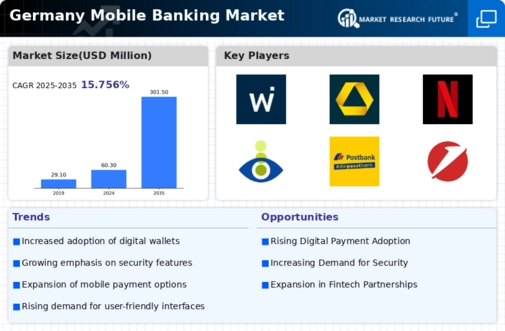Rise of Fintech Innovations
The emergence of fintech companies in Germany is reshaping the mobile banking market. These innovative firms are leveraging technology to offer unique financial solutions that cater to the evolving needs of consumers. With a focus on user experience, many fintechs provide streamlined mobile banking applications that simplify financial management. As of 2025, the fintech sector in Germany is projected to grow by 15% annually, indicating a robust interest in digital financial services. This growth is likely to attract traditional banks to collaborate with fintechs, enhancing their mobile banking offerings. The integration of innovative features such as budgeting tools, investment options, and personalized financial advice within mobile banking apps is expected to further engage users. Consequently, the mobile banking market may witness increased competition and diversification of services.
Increasing Smartphone Penetration
The proliferation of smartphones in Germany is a pivotal driver for the mobile banking market. As of 2025, approximately 85% of the population owns a smartphone, facilitating access to banking services via mobile applications. This trend indicates a shift in consumer behavior, with more individuals opting for mobile banking solutions over traditional banking methods. The convenience of managing finances remotely is appealing, particularly to younger demographics who prioritize digital solutions. Furthermore, the integration of advanced features in smartphones, such as biometric authentication, enhances user experience and security, thereby fostering trust in mobile banking services. As smartphone adoption continues to rise, it is likely that the mobile banking market will experience substantial growth, with an increasing number of users engaging in mobile transactions and financial management.
Regulatory Support for Digital Banking
The regulatory landscape in Germany is evolving to support the mobile banking market. Recent initiatives by the Federal Financial Supervisory Authority (BaFin) aim to create a conducive environment for digital banking innovations. Regulations that promote transparency and consumer protection are likely to enhance user confidence in mobile banking services. For instance, the implementation of the Payment Services Directive 2 (PSD2) encourages competition and innovation among financial service providers. This regulatory framework not only facilitates secure transactions but also allows third-party providers to offer value-added services. As a result, the mobile banking market is expected to expand, with more players entering the space and offering diverse financial solutions tailored to consumer needs. The ongoing regulatory support may further stimulate investment in technology and infrastructure, driving the market forward.
Growing Demand for Contactless Payments
The demand for contactless payment solutions is surging in Germany, significantly impacting the mobile banking market. As of 2025, around 60% of all transactions are conducted via contactless methods, reflecting a shift in consumer preferences towards speed and convenience. This trend is particularly pronounced among younger consumers who favor quick and efficient payment options. Mobile banking applications are increasingly incorporating contactless payment features, allowing users to make transactions seamlessly using their smartphones. The convenience of tapping a phone to pay, coupled with enhanced security measures, is likely to drive further adoption of mobile banking services. As merchants continue to upgrade their payment systems to accommodate contactless transactions, the mobile banking market is poised for growth, with an increasing number of users embracing this technology.
Consumer Preference for Financial Control
There is a notable shift in consumer preferences towards greater control over personal finances, which is driving the mobile banking market in Germany. As individuals seek more autonomy in managing their financial activities, mobile banking applications are increasingly being designed to provide comprehensive tools for budgeting, tracking expenses, and setting financial goals. This trend is particularly evident among millennials and Gen Z, who prioritize transparency and accessibility in their banking experiences. The ability to monitor transactions in real-time and receive instant notifications enhances user engagement and satisfaction. As consumers continue to demand more personalized and user-friendly banking solutions, the mobile banking market is likely to expand, with providers focusing on developing features that empower users to take charge of their financial well-being.

















Leave a Comment